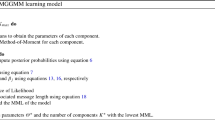Abstract
We propose a non-negative real-valued model of hierarchical classes (HICLAS) for two-way two-mode data. Like the other members of the HICLAS family, the non-negative real-valued model (NNRV-HICLAS) implies simultaneous hierarchically organized classifications of all modes involved in the data. A distinctive feature of the novel model is that it yields continuous, non-negative real-valued reconstructed data, which considerably expands the application range of the HICLAS family. The expansion implies a major algorithmic challenge as it involves a move from the typical discrete optimization problems in HICLAS to a mixed discrete-continuous one. To solve this mixed discrete-continuous optimization problem, a two-stage algorithm combining a simulated annealing and an alternating local descent stage is proposed. Subsequently it is evaluated in a simulation study. Finally, the NNRVHICLAS model is applied to an empirical data set on anger.
Similar content being viewed by others
References
AARTS, E.H.L., and LENSTRA, J.K. (1997), Local Search in Combinatorial Optimization, New York: Wiley.
BACCELLI, F., COHEN, G., OLSDER, G.-J., and QUADRAT, J.-P. (1993), Synchronization and Linearity: An Algebra for Discrete Event Systems, London: John Wiley & Sons.
BRUSCO,M.J. (2001), “A Simulated Annealing Heuristic for Unidimensional and Multidimensional (City-Block) Scaling of Symmetric Proximity Matrices”, Journal of Classification, 18, 3–33.
CARROLL, J.D., and ARABIE, P. (1980), “Multidimensional Scaling”, Annual Review of Psychology, 31, 607–649.
CEULEMANS, E., and KIERS, H.A.L. (2006), “Selecting Among Three-Mode Principal Component Models of Different Types and Complexities: A Numerical Convex Hull Based Method”, British Journal of Mathematical and Statistical Psychology, 59, 133–150.
CEULEMANS, E., and VAN MECHELEN, I. (2003), “Uniqueness of N-Way N-Mode Hierarchical Classes Models”, Journal of Mathematical Psychology, 47, 259–264.
CEULEMANS, E., and VAN MECHELEN, I. (2004), “Tucker2 Hierarchical Classes Analysis”, Psychometrika, 69, 375–399.
CEULEMANS, E., VAN MECHELEN, I., and KUPPENS, P. (2004), “Adapting the Formal to the Substantive: Constrained Tucker3-HICLAS”, Journal of Classification, 21, 19–50.
CEULEMANS, E., VAN MECHELEN, I., and LEENEN, I. (2003), “Tucker3 Hierarchical Classes Analysis”, Psychometrika, 68, 413–433.
CEULEMANS, E., VAN MECHELEN, I., and LEENEN, I. (2007), “The Local Minima Problem in Hierarchical Classes Analysis: An Evaluation of a Simulated Annealing Algorithm and Various Multistart Procedures”, Psychometrika, 72, 377–391.
CHATURVEDI,A., and CARROLL, J.D. (1994), “An Alternating Combinatorial Optimization Approach to Fitting the INDCLUS and Generalized INDCLUS Models”, Journal of Classification, 11, 155–170.
DE BOECK, P., and ROSENBERG, S. (1988), “Hierarchical Classes: Model and Data Analysis”, Psychometrika, 53, 361–381.
DE BOECK, P., and VANMECHELEN, I. (1990), “Traits and Taxonomies: A Hierarchical Classes Approach”, European Journal of Personality, 4, 147–156.
GARA, M.A., SILVER, R.C., ESCOBAR, J.I., HOLMAN, A., and WAITZKIN, H. (1998), “A Hierarchical Classes Analysis (HICLAS) of Primary Care PatientsWith Medically Unexplained Somatic Symptoms”, Psychiatry Research, 81, 77–86.
KUPPENS, P., and VAN MECHELEN, I. (2007), “Interactional Appraisal Models for the Anger Appraisals of Threatened Self-Esteem, Other-Blame, and Frustration”, Cognition & Emotion, 21, 56–77.
KUPPENS, P., VAN MECHELEN, I., SMITS, D. J.M., and DE BOECK, P. (2003), “The Appraisal Basis of Anger: Specificity, Necessity and Sufficiency of Components”, Emotion, 3, 254–269.
KUPPENS, P., VAN MECHELEN, I., SMITS, D. J.M., DE BOECK, P., and CEULEMANS, E. (2007), “Individual Differences in Patterns of Appraisal and Anger Experience”, Cognition & Emotion, 21, 689–713.
LEENEN, I., VAN MECHELEN, I., DE BOECK, P., and ROSENBERG, S. (1999), “INDCLAS: A Three-Way Hierarchical Classes Model”, Psychometrika, 64, 9–24.
MISCHEL,W., and SHODA, Y. (1998), “Reconciling Processing Dynamics and Personality Dispositions”, Annual Review of Psychology, 49, 229–258.
MURILLO, A., VERA, J.F., and HEISER, W.J. (2005), “A Permutation-Translation Simulated Annealing Algorithm for L1 and L2 Unidimensional Scaling”, Journal of Classification, 22, 119–138.
NOCEDAL, J., and WRIGHT, S.J. (1999), Numerical Optimization, New York: Springer.
REID, A., and DEAUX, K. (1996), “Relationship Between Social and Personal Identities: Segregation or Integration?”, Journal of Personality and Social Psychology, 71, 1084–1091.
SCHEPERS, J., and HOFMANS, J. (2009), “TwoMP: aMATLAB Graphical User Interface for Two-Mode Partitioning”, Behavior Research Methods, 41, 507–514.
SCHEPERS, J., CEULEMANS, E., and VAN MECHELEN, I. (2008), “Selecting Among Multi-Mode Partitioning Models of Different Complexities: A Comparison of Four Model Selection Criteria”, Journal of Classification, 25, 67–85.
SCHEPERS, J., and VAN MECHELEN, I. (2010), “Uniqueness of Real-Valued Hierarchical Classes Models”, Journal of Mathematical Psychology, 54, 215–221.
STIRRATT, M.J., MEYER, I.H., OUELLETTE, S.C., and GARA, M.A. (2008), “Measuring Identity Multiplicity and Intersectionality: Hierarchical Classes Analysis (HICLAS) of Sexual, Racial, and Gender Identities”, Self and Identity, 7, 89–111.
VAN MECHELEN, I., and DE BOECK, P. (1989), “Implicit Taxonomy in Psychiatric Diagnosis: A Case Study”, Journal of Social and Clinical Psychology, 8, 276–287.
VAN MECHELEN, I., DE BOECK, P., and ROSENBERG, S. (1995), “The Conjunctive Model of Hierarchical Classes”, Psychometrika, 60, 505–521.
VANMECHELEN, I., LOMBARDI, L., and CEULEMANS, E. (2007), “Hierarchical Classes Modeling of Rating Data”, Psychometrika, 72, 475–488.
VAN ROSMALEN, J., GROENEN, P.J.F., TREJOS, J. and CASTILLO W. (2009), “Optimization Strategies for Two-Mode Partitioning”, Journal of Classification, 26, 155–181.
VANSTEELANDT,K., and VANMECHELEN, I. (1998), “Individual Differences in Situation-Behavior Profiles: A Triple Typology Model”, Journal of Personality and Social Psychology, 75, 751–765.
VANSTEELANDT,K., and VANMECHELEN, I. (2006), “Individual Differences in Anger and Sadness: In Pursuit of Active Situational Features and Psychological Processes”, Journal of Personality, 74, 871–910.
VERA, J.F., MACIAS, R., and HEISER, W.J. (2009), “A Dual Latent Class Unfolding Model for Two-Way Two-Mode Preference Rating Data”, Computational Statistics and Data Analysis, 53, 3231–3244.
Author information
Authors and Affiliations
Corresponding author
Additional information
J. Schepers and I. van Mechelen were supported by the Fund for Scientific Research-Flanders (Belgium), Project No. G.0146.06 awarded to Iven van Mechelen and by the Research Council KULeuven (GOA/2005/04). The authors would like to thank Peter Kuppens for providing the data set on anger.
Rights and permissions
About this article
Cite this article
Schepers, J., Van Mechelen, I. & Ceulemans, E. The Real-Valued Model of Hierarchical Classes. J Classif 28, 363–389 (2011). https://doi.org/10.1007/s00357-011-9089-5
Published:
Issue Date:
DOI: https://doi.org/10.1007/s00357-011-9089-5




